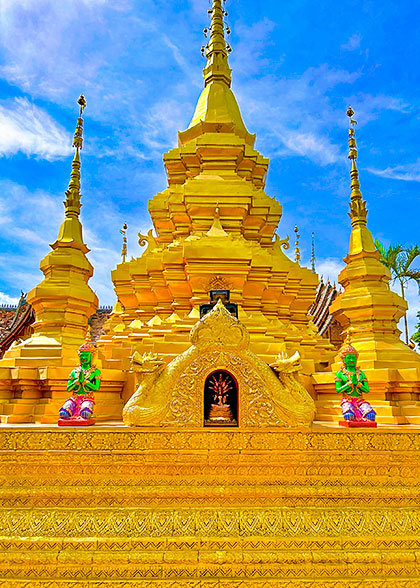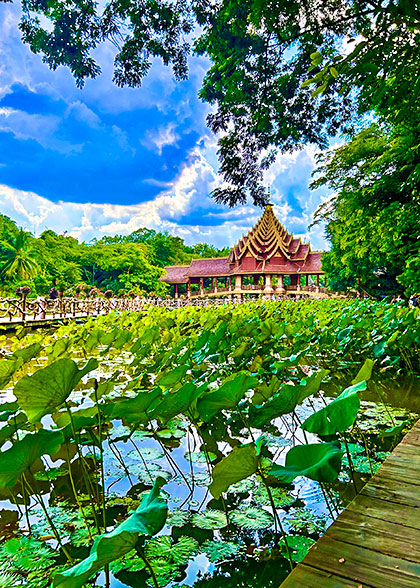Xishuangbanna Travel Guide
Xishuangbanna Facts
Chinese Name: 西双版纳傣族自治州 (xī shuāng bǎn nà dǎi zú zì zhì zhōu)
Population: 1,196,000
Area: 19,124.5 square kilometers (7,384.0 square miles)
Location: in the south of Yunnan, southwest China
Administrative Division: 2 counties (Menghai, Mengla); 1 county-level cities (Jinghong)
Area Code: 0691
Zip Code: 666100
GDP (2019): CNY 56.809 billion (USD 8.234 billion)
Nationalities: Dai, Han, Hani, Lahu, Yi, Blang
Experiencing Jungle Treks & Dai Villages and Customs
Xishuangbanna Dai Autonomous Prefecture is located at the south end of Yunnan Province. It shares a boundary of 966 kilometers (619 miles) with Burma and Laos to the east, south and west, being a vital pass from China to Indo-China Peninsular by land. There is no doubt that Xishuangbanna is a must-see stop on a trip to Yunnan. This city boasts lush tropical rain forests with a variety of rare animals and plants. It is easy to get close to beautiful peacocks, wild elephants, monkeys and other animals at Wild Elephant Valley and Xishuangbanna Primeval Forest Park. The exquisite and unique Dai bamboo buildings and ancient Buddhist temples and pagodas are hidden in the green trees, showing a natural, simple and peaceful living atmosphere. The Water-Sprinkling Festival in April is a carnival of the whole city, which should not be missed.
Attractions - Things to Do
As the only tropical rain forest nature reserve in China, the area has surprising biological diversity in the virgin forest, particularly because it is so far away from central China and considered isolated. In religion, it is greatly influenced by Hinayana Buddhism of Southeast Asia. The enticing white masonry structure, Manfeilong Buddhist Pagoda, is the quintessence of Hinayana Buddhist architecture. The main pagoda is comprised of eight small pagodas, like a cluster of bamboo shoots.
 |  |
 Single-Tree Forest: A tree does not make a forest. But a nine hundred year old banyan in Daluo Town here is exception. It covers an area of 120 square meters (143.6 square yards) with over thirty stand roots. This 70-meter-high (230-feet-tall) banyan is an attractive and marvelous forest in itself.
Single-Tree Forest: A tree does not make a forest. But a nine hundred year old banyan in Daluo Town here is exception. It covers an area of 120 square meters (143.6 square yards) with over thirty stand roots. This 70-meter-high (230-feet-tall) banyan is an attractive and marvelous forest in itself.
Wild Elephant Valley: Chinese wild elephants are only found in the virgin forest of the Wild Elephant Valley, located in the Mengyang Nature Reserve, 45 kilometers (28 miles) from Jinghong. There are hostels in the elephant park. Cabins in trees on riverbank are the most perfect localities to admire the elephants.  Manfeilong Buddhist Pagoda: It is a Hinayana Buddhist architecture complex consisted of nine masonry pagodas of all sizes. It is also known as the White Pagoda due to its pure white structure. During the Water-Sprinkling Festival, crowds of the Dai people in Manfeilong Village will gather in front of the pagoda to celebrate the New Year of the Dai Calendar.
Manfeilong Buddhist Pagoda: It is a Hinayana Buddhist architecture complex consisted of nine masonry pagodas of all sizes. It is also known as the White Pagoda due to its pure white structure. During the Water-Sprinkling Festival, crowds of the Dai people in Manfeilong Village will gather in front of the pagoda to celebrate the New Year of the Dai Calendar.  Olive Dam: It is the lowest and hottest place in this area. However, its torrid climate brings rich tropical fruits and products. It consists of two stockaded villages, each of which is highlighted by an eyeful of typical Burma styled Buddhist pagodas and bamboo building of the Dai minority.
Olive Dam: It is the lowest and hottest place in this area. However, its torrid climate brings rich tropical fruits and products. It consists of two stockaded villages, each of which is highlighted by an eyeful of typical Burma styled Buddhist pagodas and bamboo building of the Dai minority. ![]() Other Scenic Spots: Mandian Waterfall, Xishuangbanna Tropical plant Research Insititute, Nationality Culture Park, Old Town of Yiwu
Other Scenic Spots: Mandian Waterfall, Xishuangbanna Tropical plant Research Insititute, Nationality Culture Park, Old Town of Yiwu
How to Get to Xishuangbanna
1. Xishuangbanna Airport is located in Gasa Town, Jinghong City, Xishuangbanna Dai Autonomous Prefecture, Yunnan Province, Xishuangbanna Gasa International Airport is about 5.5 kilometers (about 3.5 miles) from downtown Jinghong. Airport shuttle bus and city bus for passengers travel between airport and Jinghong City.
2. There are a total of three public bus lines in Jinghong city proper. All the scenic spots and passenger transport stations inside Jinghong City can be reached by bus. Recently, renting a bicycle while visiting a city has gained popularity. As Jinghong city is not very big, seeing the city by bicycle would be pleasant and convenient.
Weather
The weather in this region is a combination of continental and oceanic climates with an annual average temperature of 18-22℃ (64.4-71.6℉). The coldest November is similar to the middle of summer in the lower reaches of the Yangtze River; thereby, Xishuangbanna is reputed as a happy land without winter. Generally, there are only two seasons. May to October is the rainy season and November to April is the dry season. Although it is an all-year-round tourist destination, the weather is most favourable from November to April. However since the roads conditions are excellent, this place is also a popular destination during the rainy season.
Xishuangbanna Travel Tips
![]() Special Local Products: tea, coffee, tropical fruit, herbs, Yunnan tobacco
Special Local Products: tea, coffee, tropical fruit, herbs, Yunnan tobacco
![]() Local Highlights: The Water-sprinkling Festival is New Year's Day for the Dai, and is the most important and grandest festival of the year. It lasts three days from 13th to 15th, April (the sixth month of the Dai Calendar). Dai people dip branches into the river and sprinkle the water onto others as a way to express their best wishes. In addition, the festivals of the Hani, Jino and Yao ethnic minorities are also delightful part of local ethnic customs.
Local Highlights: The Water-sprinkling Festival is New Year's Day for the Dai, and is the most important and grandest festival of the year. It lasts three days from 13th to 15th, April (the sixth month of the Dai Calendar). Dai people dip branches into the river and sprinkle the water onto others as a way to express their best wishes. In addition, the festivals of the Hani, Jino and Yao ethnic minorities are also delightful part of local ethnic customs.